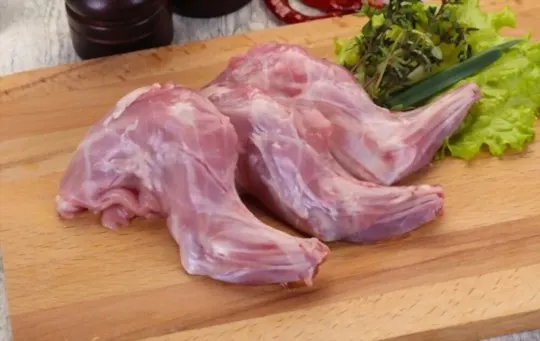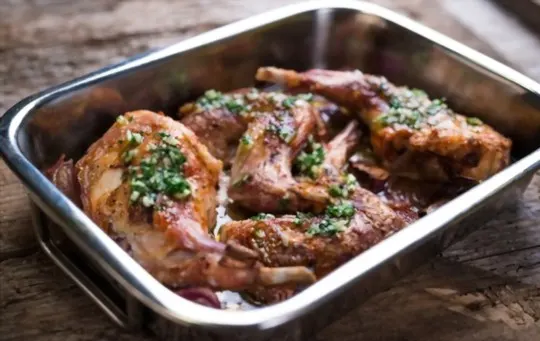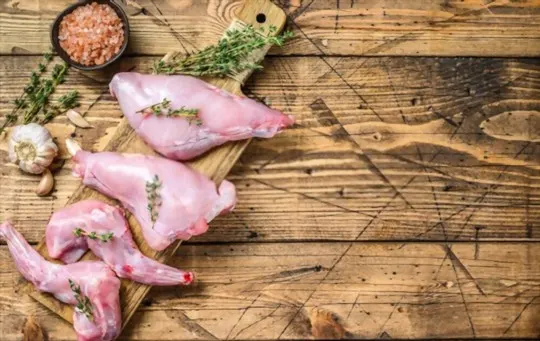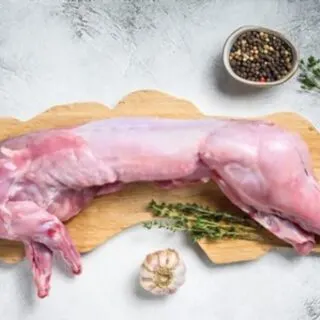Rabbit meat has a unique taste that has been enjoyed for centuries.
Rabbit is considered to be a delicacy in many cultures around the world, but there are some misconceptions about how it tastes.
Rabbit meat is mild, tender and slightly sweet with a delicate texture and flavor.
It is high in protein and low in fat and cholesterol, making it an ideal choice for anyone looking to incorporate more lean meats into their diet.
This guide will explain what rabbit meat tastes like, its nutritional benefits, tips on buying and preparing rabbit, as well as the different types of dishes you can make with it.
What is Rabbit Meat?

Rabbit meat is a popular and healthy lean protein that is gaining in popularity for its versatility and health benefits.
Rabbit meat has an earthy, nutty flavor with a delicate texture, similar to chicken but richer tasting.
The versatility of rabbit meat allows it to be fried, grilled, roasted, braised and sautéed in different types of sauces.
Rabbit is also low in fat and calories with plenty of protein and mineral content, making it an ideal choice for those looking to stay healthy while still enjoying a delicious meal.
Rabbit meat is also often hailed as being one of the most sustainable sources of protein available today.
As natural pest control agents, rabbits are able to reproduce at a fast rate while consuming minimal resources compared to other animals such as cows and pigs.
Additionally, rabbits require very little space and maintenance which makes raising them easier than some other livestock for those interested in animal husbandry or sustainable farming practices.
Though the taste of rabbit can vary depending on the age or breed of the rabbits used for consumption — young rabbits tend to have more delicate flavor while older rabbits may have more assertive flavors — there are many ways that rabbit can be prepared for optimal taste: marinating or brining may help keep cooked rabbit moist; heating over low heat will prevent toughness; adding a layer of fat like bacon can help prevent drying out during cooking time; using herbs like tarragon or oregano can give an herbal flavor element; glazing with maple syrup may provide sweetness; coating with spices like smoked paprika or chili powder can add complexity to the end product.
The options are endless – explore culinary possibilities with this versatile ingredient.
What Does Rabbit Taste Like? Does it Taste Good?

Rabbit meat is often presented and cooked in a very similar way to chicken, which leads many to wonder if the flavors are similar.
Rabbit has a delicate, mild taste that some have likened to veal or sweet chicken.
Rabbit is low in fat, high in protein and can be cooked in a variety of ways to create unique flavor experiences.
Do not expect rabbit meat to have strong flavor notes; it is very subtle and may be overlooked unless prepared with herbs, spices or sauces.
If you’re looking for an intensely flavorful game meat experience, try roasted venison or wild boar.
Rabbit is best when cooked slowly over low heat in a liquid base — tomato sauce, wine or vegetable broth are all excellent choices for unlocking the tenderness and full flavor of this versatile white-meat option.
Rabbit pairs well with ingredients long beloved in French cuisine: creamy béchamel sauces (think croque monsieur.
), herbs de Provence mixes, garlic, shallots and mustard.
When pan-frying rabbit pieces for stew dishes, render the fat first for crispness before you add vegetables at the end — this will bring out even more delicate flavor from your finished meal.
Factors that Affect the Taste of Rabbit Meat

The taste of rabbit meat is influenced by many factors including the breed, diet, age and preparation method.
Breeds such as Rex, Flemish Giant and Champagne D’Argent have a more mellow flavor than smaller breeds like Angora or Mini Lop.
In general, younger rabbits tend to have a milder flavor than mature rabbits.
The diet of the rabbit has a significant impact on its flavor.
Rabbits that are grass-fed or organically raised or supplemented may produce better tasting meat than those that are fed low-grade pellets and treated with hormones or antibiotics.
Similarly, game birds that eat nuts and berries may produce more flavorful meat than those that eat only seeds and corn.
The most important factor in determining the taste of rabbit meat is how it is prepared.
In general, roasting is the best way to cook a whole rabbit since it helps to protect its delicate texture while maximizing its flavor.
Braised dishes such as stews can also be made with rabbit meat but they should not overcook because this will dry out the meat too much resulting in an unpleasant texture and taste.
Adding herbs, spices, marinades and other flavoring agents can also improve the taste of rabbit meat considerably.
1 – Age
The flavor of a rabbit can vary significantly based on its age.
Rabbits that are two months or under tend to have a mild, slightly sweet flavor with delicate texture.
Meanwhile, older rabbits may have a more gamey flavor with firmer flesh.
Also, the way in which the rabbit is cooked and seasoned can greatly impact its overall taste.
For example, basting a young rabbit in butter or marinating an older one in spices can bring out unique flavors in different age ranges of rabbit.
2 – Diet
The diet of a wild rabbit plays a huge role in the taste of the meat they produce; in the UK, our wild bunnies mainly get their nutrition from grass, herbs and hay.
This grass diet helps to give the meat that slightly sweet and mild flavour.
On top of this, rabbits are naturally lean animals with very little fat — so you won’t be getting anything like chicken thighs here.
High fibre is also essential for rabbit health, so good quality hay should make up a significant chunk of their daily nutrition — presumably explaining why rabbits thought to have been raised on grain-based diets can often taste greasy and off-flavoured.
Unfortunately, diet isn’t always something we’re able to consider when sourcing our meat — ask any butcher or supermarket worker to find out what kind of food has gone into a particular rabbit dish or blankmeat product.
However, it could be worth going out of your way to find free-range or even wild catch products where these dietary characteristics are more likely.
3 – Preparation Method
Properly preparing rabbit before cooking is essential for a delicious final product.
Rabbit contains very little fat, and can dry out easily if not cooked properly; this is why marinating or tenderizing the meat before cooking is so important.
In order to prevent the meat from drying out, seasoning the rabbit with herbs and spices, coating it with oil or butter, or wrapping it in bacon are great options.
When baking, roasting or grilling rabbit, using lower temperatures and shorter cooking times helps keep the meat moist while still earning flavor from whatever seasonings and ingredients you choose to use.
Braising rabbit is one of the best methods if you’re looking to retain moisture during cooking as well; Braising involves simmering slowly in a bit of water, which affects the protein differently than when grilling or roasting.
Overall, choosing your seasonings wisely (try thyme, rosemary or crushed chili), pre-marinating with osso buco-style flavors such as orange juice and fresh herbs make for an even more robust flavour profile.
Keeping an eye on it while cooking provides the most success when making sure your rabbit does not dry out.
How to Cook Rabbit Meat to Enhance its Flavor

Cooking rabbit meat correctly can help to enhance its flavor and make it more enjoyable.
The lean and mild taste of rabbit can make it an appealing option for those looking for a healthier alternative to red meats.
To ensure that your meal is cooked to perfection, there are a few tips and tricks you should keep in mind.
The most basic step in cooking rabbit meat is to season it with salt or other desired herbs or spices before adding it to the recipe.
This will help bring out the flavor of the meat and make it more enjoyable.
Additionally, marinating the meat before cooking can help give it an even deeper, richer flavor.
For marinades, you can use either oil-based or vinegar-based recipes depending on your particular tastes.
When you are ready to cook the rabbit, you should bake, roast, or grill it in order to best preserve its delicate flavors.
Make sure that you do not overcook your dish as this will result in dry and tough meat that has lost much of its original flavor profile.
Instead allow the flavors of your ingredients, such as herbs and spices, oils and vinegars come together during cooking time while still preserving moisture within the recipe by reducing heat+time considerations during preparation time allowing juices within the rabbit remain intact when served at optimal temperatures making for pleasantly flavored meals.
Is Rabbit Meat Healthy?

When it comes to rabbits and their meat, certain health benefits come with consuming them.
Rabbit meat is a lean source of protein that can help with weight management, promoting muscle repair and growth, strengthening the metabolism, and supplying energy to the body.
Rabbit meat is also a great source of B vitamins, particularly B12.
These vitamins are essential for many bodily functions like heart and immune system health.
Rabbit meat also contains potassium, zinc, and iron which are essential minerals for human consumption when considering overall health and wellness.
In addition, rabbit meat also has significant levels of calcium and phosphorus which are known to help improve digestion by helping to prevent hardening of the arteries.
The high levels of fatty acids like Omega-3 within rabbit meat make it beneficial for cell health, as well as helping boost brain development in children if consumed in reasonable amounts.
Conclusion
In conclusion, rabbit meat is mild and slightly sweet in taste, with a more delicate texture than that of chicken.
Rabbit can be prepared as a main course, used in stews and soups, or even substituted for chicken or other poultry in recipes.
It’s high in lean protein and fat-free—making it a great choice for those trying to keep their diet low-fat.
Rabbit meat tastes great when prepared with herbs and spices—accents from cuisines like Cajun, French, Italian, Spanish and Mexican all work well.
You can opt for roasted rabbit served with potatoes or carrots; pulled rabbit dishes; and sauces made from gravy to cream or white wine sauces.
Whether you’re an experienced home chef looking for something new for your repertoire or an adventurous gourmet looking to try something new, rabbit meat is a delicious way to close out the meal.

What Does Rabbit Taste Like? A Comprehensive Guide
Ingredients
- Rabbit meat
- Ingredients from your selected recipes
Instructions
- Select ingredients that work well together.
- Use a recipe or method that will enhance their natural taste.
- Taste and adjust the recipe as needed to achieve the desired flavor.

Carrie is a food writer and editor with more than 15 years of experience. She has worked for some of the biggest names in the food industry, including Bon Appétit, Food & Wine, and Martha Stewart Living.
As the Editor in Chief of IntroChicago.com, Carrie oversees all of the content on the site. She also manages the team of contributing writers and editors, who help to create delicious recipes, helpful tips, and informative articles that you’ll find on the site.
A native of the Chicago area, Carrie is passionate about all things food. She loves trying new restaurants and experimenting with new recipes in her kitchen. She’s also a graduate of the Culinary Institute of America, so she knows a thing or two about food!
